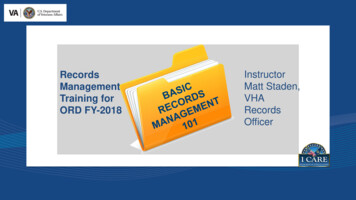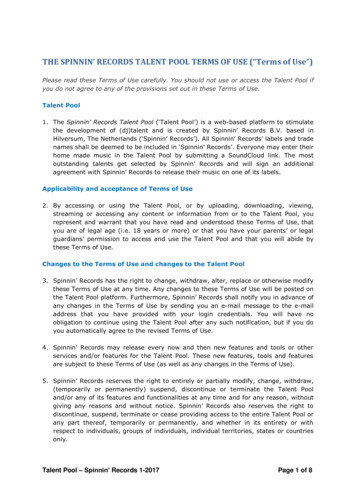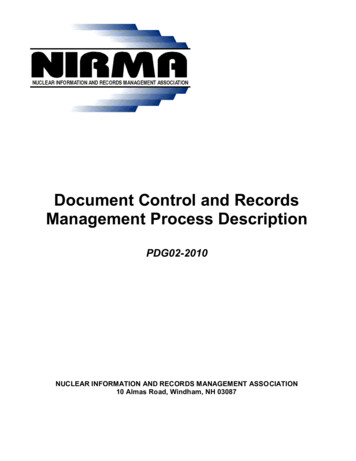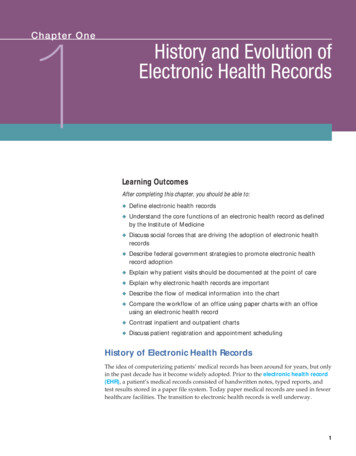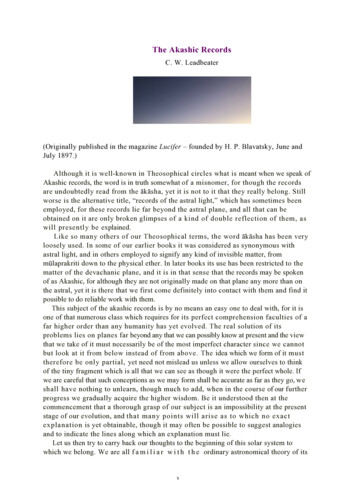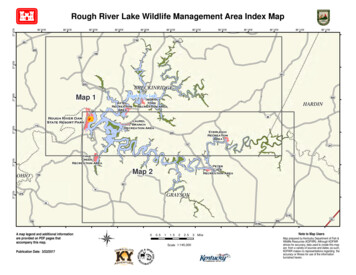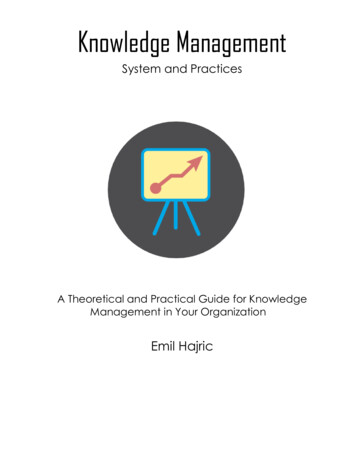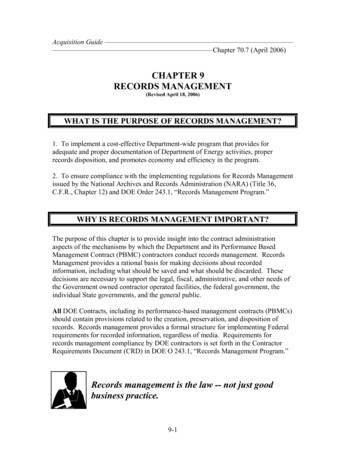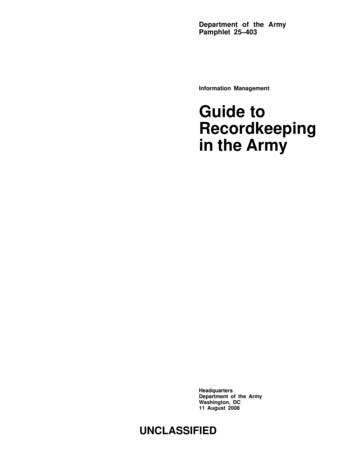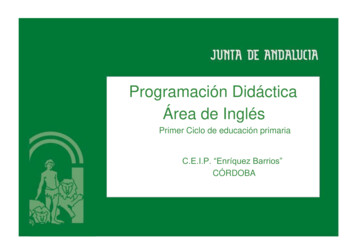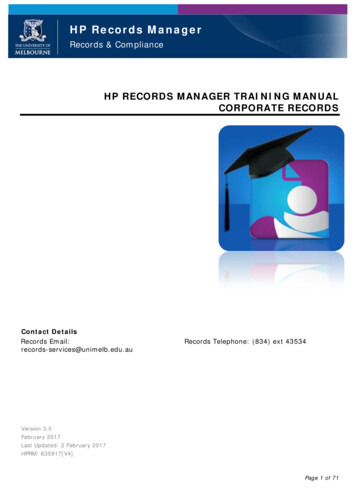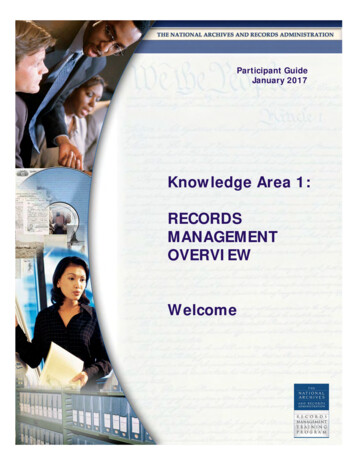
Transcription
Participant GuideJanuary 2017Knowledge Area 1:RECORDSMANAGEMENTOVERVIEWWelcome
[This page intentionally left blank.]
WelcomeTable of ContentsTable of ContentsAdministrative Items . 1Administrative Items. 2Cancellation and Attendance Policies. 3Getting to Know You. 4Your Records Management Experience . 5About NARA . 6Course Outline . 8NARA’s Knowledge Areas and Certificate of Federal Records Management Training. 9Course Objectives . 10Course Agenda. 11Course Materials . 12Applying What You Learned. 13Action Items Worksheets. 14Why Are We Here?. 15Records Management from a High-Level View. 16Consequences of Poor Records Management. 18Do Records Matter? . 20Knowledge Area 1: Records Management OverviewJanuary 2017PG Welcome-i
WelcomeTable of Contents[This page intentionally left blank.]Knowledge Area 1: Records Management OverviewJanuary 2017PG Welcome-ii
WelcomeCourse OutlineAdministrative ItemsSlide Welcome-1NOTESKnowledge Area 1: Records Management OverviewJanuary 2017PG Welcome-1
WelcomeCourse OutlineAdministrative ItemsSlide Welcome-2 Emergency proceduresEmergency exitsRestroomsBreak facilitiesLunch facilitiesCancellation policyCourse attendance policyPlease turn off mobile devices**Mobile devices include, but are not limited to, portable computers, laptops or notebooks,netbooks, tablet computers, electronic readers, PDAs, smartphones, BlackBerrys andMP3 players.NOTESKnowledge Area 1: Records Management OverviewJanuary 2017PG Welcome-2
WelcomeCourse OutlineCancellation and Attendance PoliciesNARA reserves the right to postpone or cancel a course at any time. We will make every effortto contact registrants by email and telephone if that occurs. Courses WILL BE CANCELLED ifthe Office of Personnel Management (OPM) announces a “closed,” “unscheduled leave,” “liberalleave,” or “delay arrival” policy for Federal employees for that day or if there has been anelevation to threat level RED in the Homeland Security status. Official government closure andleave policy is located on the OPM website at OPM website.Attendance Policy for NARA Courses – Course completion requires that you attend all coursesessions. Instructors may deny a course completion certificate for unexcused absences whichmay require retaking the course for additional fees.NOTESKnowledge Area 1: Records Management OverviewJanuary 2017PG Welcome-3
WelcomeCourse OutlineGetting to Know YouSlide Welcome-3In this workshop, we’ll discuss the people, processes, technology and tools needed in effectiverecords programs. Let’s get to know each other by focusing first on people.If you were going on a long-term mission to outer space, which three people (from today, fromhistory, or from literature, movies, etc.) would you want with you, and why? You can assumeyou’ll have a professional crew to pilot the ship, navigate, and provide basic care for thepassengers. Take a moment to think about your choices, then discuss them with your group.Once you’ve learned about each person in your table group, it’s time to assemble our spaceflightdream team. As a group, choose two people from your lists to recommend to the class as awhole. Select one spokesperson who will share your two recommendations and tell why youpicked them.When we return to the full class, your spokesperson will share your two choices, and theneveryone in your table group will briefly introduce him/herself (name, agency/organization, andcity).NOTESKnowledge Area 1: Records Management OverviewJanuary 2017PG Welcome-4
WelcomeCourse OutlineYour Records Management ExperienceSlide Welcome-4How much records management experience do you have? Less than one yearOne to four yearsFive or more yearsHow much time do you spend on records management tasks every month? 80 100% of my time50 79% of my time25 49% of my time10 24% of my timeLess than 10% of my timeNOTESKnowledge Area 1: Records Management OverviewJanuary 2017PG Welcome-5
WelcomeCourse OutlineAbout NARASlide Welcome-5As you probably know by now, NARA stands for the National Archives and RecordsAdministration. We are the archivists and records management experts who provide guidance formanaging Federal records and other business information.More formally, NARA holds a public trust that enables officials and agencies to review theiractions and helps citizens hold them accountable. NARA ensures continuing access to essentialevidence that documents: The rights of American citizensThe actions of Federal officialsThe national experienceNOTESKnowledge Area 1: Records Management OverviewJanuary 2017PG Welcome-6
WelcomeCourse OutlineSlide Welcome-6As part of that mission, NARA: Determines what evidence is essential for such documentationEnsures that government creates such evidenceMakes it easy for users to access that evidenceIs here to help youNARA manages a network of Archives, Presidential Libraries, Federal Records Centers, andother programs across the country, providing access to millions of documents, photographs,sound and video recordings, maps, information systems, and other items that document thehistory of our Federal government, our communities, and our national experience.You’ll find more information about NARA’s holdings, programs, locations, activities, and staffon our website at archives.gov.NOTESKnowledge Area 1: Records Management OverviewJanuary 2017PG Welcome-7
WelcomeCourse OutlineCourse OutlineSlide Welcome-7NOTESKnowledge Area 1: Records Management OverviewJanuary 2017PG Welcome-8
WelcomeCourse OutlineNARA’s Knowledge Areas (KAs) and Certificate of Federal RecordsManagement TrainingSlide Welcome-8With the constant changes in Information Technology and Federal recordkeeping, NARA ischallenged to pursue strategies to ensure that records professionals have current knowledge andskills to do their jobs effectively. NARA offers a program that certifies individuals aftersuccessful completion of training in Federal records management. Knowledge Area 1: RecordsManagement Overview supplies the records management foundations for the other five KAcourses (KA 2 to KA 6) that make up NARA’s Federal records management training certificateprogram.For more information about the records management courses offered by NARA,see e Area 1: Records Management OverviewJanuary 2017PG Welcome-9
WelcomeCourse OutlineCourse ObjectivesSlide Welcome-9At the completion of this course, you will be able to: Demonstrate that effective records management adds value to agency business processesIdentify the stakeholders and explain their primary roles and responsibilitiesExplain how an agency creates and maintains trustworthy recordsExplain the importance of developing records management strategiesNOTESKnowledge Area 1: Records Management OverviewJanuary 2017PG Welcome-10
WelcomeCourse OutlineCourse AgendaSlide Welcome-10 WelcomeCourse OutlineModule 1: PeopleModule 2: ProcessesModule 3: Technology, Tools, and ResourcesCourse Wrap-UpNOTESKnowledge Area 1: Records Management OverviewJanuary 2017PG Welcome-11
WelcomeCourse OutlineCourse MaterialsSlide Welcome-11 Knowledge Area 1: Records Management Overview Participant Guide (PG)–KA 1 Modules 1 through 3–KA 1 Handouts–KA 1 ReferencesNOTESKnowledge Area 1: Records Management OverviewJanuary 2017PG Welcome-12
WelcomeApplying What You LearnedApplying What You LearnedSlide Welcome-12NOTESKnowledge Area 1: Records Management OverviewJanuary 2017PG Welcome-13
WelcomeApplying What You LearnedAction Items WorksheetsSlide Welcome-13Training is useful only if you can apply it to your everyday responsibilities. It is important thatyou use the information and concepts you learn in this course to create a plan of action for whenyou return to your office.To facilitate development of your plan, you will be given a few minutes at the end of each moduleto complete an Action Items Worksheet so you can reflect on what you have learned in themodule and how you will apply it to your job. The worksheets will also give you a venue forrecording any “aha!” moments you may have had during the module, including moments you sooften forget upon leaving the training environment and returning to your office.During this time, you will also be given the opportunity to share voluntarily items from yourAction Items Worksheet with the rest of the class.NOTESKnowledge Area 1: Records Management OverviewJanuary 2017PG Welcome-14
WelcomeWhy Are We Here?Why Are We Here?Slide Welcome-14NOTESKnowledge Area 1: Records Management OverviewJanuary 2017PG Welcome-15
WelcomeWhy Are We Here?Records Management from a High-Level ViewSlide Welcome-15Today’s records management environment is ever-changing, fast-paced, and electronicallydriven. The records management challenges include the following: There is a decline in staff who specialize in filingGrowing investment is being made in software functionality that creates records but doesnot manage themMission-critical records are often not sharable, retrievable, or usableCopies proliferate; data are conflicting or unreliableEmail, instant messaging, and social media technologies replace traditional phoneconversations, meetings, and formal written communicationNOTESKnowledge Area 1: Records Management OverviewJanuary 2017PG Welcome-16
WelcomeWhy Are We Here?Slide Welcome-16 Litigation and discovery costs are skyrocketingAuthenticity of information is often questionedRecords are not destroyed in a timely or appropriate mannerTools to manage electronic records lag far behind current needsNOTESKnowledge Area 1: Records Management OverviewJanuary 2017PG Welcome-17
WelcomeWhy Are We Here?Consequences of Poor Records ManagementSlide Welcome-17There are high-profile, records-related incidents, like those listed here, help illustrate the currentstate of affairs in records management: Management of email in Federal agencies Arthur Andersen and Enron – Everyone remembers the downfall of accounting giantArthur Andersen LLC in the Enron case. One of its problems was a November 12, 2001,memo that directed Andersen workers to destroy all Enron audit material, except for themost basic “work papers.”NOTESKnowledge Area 1: Records Management OverviewJanuary 2017PG Welcome-18
WelcomeWhy Are We Here?Slide Welcome-18 Missing War Records – To offset the records management problems the Armyencountered during the Gulf War, the Army developed and issued guidelines forpreserving the records. However, the guidelines were not followed in the Iraq War, 2003–2007, and a large portion of the field records were lost. Not only does the Army not havea complete history of what happened in the early years of the Iraq conflict, soldiers arehaving difficulty proving that they were even there. Without the field records, the Army,soldiers, and the Veterans Administration experienced increased challenges indocumenting what occurred and determining benefits.NOTESKnowledge Area 1: Records Management OverviewJanuary 2017PG Welcome-19
WelcomeWhy Are We Here?Do Records Matter?Slide Welcome-19Here is an example of a high-profile incident where good records management aided in theinvestigation. Records held by British Petroleum (BP), the National Archives, and Federalagencies allowed the National Commission on the BP Deepwater Horizon Oil Spill and OffshoreDrilling to complete a thorough investigation the biggest oil spill in U.S. history. Theinvestigation led to recommendations that will help prevent similar accidents in the future.Imagine how difficult the Commission’s job would have been without those records. British Petroleum (BP) Oil Spill Investigation – The BP-Deepwater Horizon oil spill, theworst in U.S. history, began after a rig explosion aboard the Deepwater Horizon in theGulf of Mexico on April 20, 2010. Eleven workers died.On May 22, 2010, President Barack Obama created the National Commission on the BPDeepwater Horizon Oil Spill and Offshore DrillingNOTESKnowledge Area 1: Records Management OverviewJanuary 2017PG Welcome-20
WelcomeWhy Are We Here? The Commission reviewed thousands of pages of documents from dozens of governmentagencies, private companies, and other entities and interviewed hundreds of witnessesfrom these same agencies, companies, and entities. Records from four major Federalagencies – the Chemical Safety Board, the Coast Guard, the Department of Energy, andthe Department of Interior were reviewed during the Commission’s investigation and inthe creation of its final report. Additional records from the Departments of Energy andInterior, in the holdings of the National Archives, were also reviewed by theCommission. All of the Commission’s files were sent to the Department of Energy forresearch, and they will be transferred to the National Archives at a later date.For more information on the National Commission on the BP Deepwater Horizon Oil Spill andOffshore Drilling, go to OTESKnowledge Area 1: Records Management OverviewJanuary 2017PG Welcome-21
WelcomeManaging Government Records Directive[This page intentionally left blank.]NOTESKnowledge Area 1: Records Management OverviewJanuary 2017PG Welcome-22
Participant GuideJanuary 2017Knowledge Area 1:RecordsManagementOverviewModule 1: People
[This page intentionally left blank.]
Module 1: PeopleTable of ContentsTable of ContentsIntroduction and Objectives . PG 1-1Objectives . PG 1-2Lesson 1: Records Management Stakeholders . PG 1-3Records Management Stakeholders . PG 1-4Roles of Records Management Stakeholders . PG 1-6Agency Head . PG 1-6Senior Agency Official (SAO). PG 1-7Chief Information Officer (CIO) . PG 1-7Program Manager (PM) or Supervisor . PG 1-7System Administrator or Information Technology Manager. PG 1-8Information Technology (IT) Staff . PG 1-8Web Manager . PG 1-8Inspector General (IG) . PG 1-9General Counsel (GC). PG 1-9Public Affairs Officer . PG 1-10Historian. PG 1-10Digital Imaging Manager . PG 1-11Federal Employee . PG 1-11Others . PG 1-12Making Records Decisions . PG 1-13Lesson Summary. PG 1-14Lesson 2: Records Management Staff . PG 1-15Roles of Records Management Staff . PG 1-16Agency Records Officer (ARO) . PG 1-16Records Liaison . PG 1-17Records Custodian . PG 1-19Agency Contractors Doing Records Work . PG 1-19Review Activity: Who Is Responsible? . PG 1-20Building Alliances with Records Management Stakeholders . PG 1-23Lesson Summary. PG 1-26Lesson 3: Records Management Competencies for All . PG 1-27Skills for Working Together . PG 1-28Records Management Responsibilities . PG 1-29What Does an Agency Records Officer Need to Know? . PG 1-30Lesson Summary. PG 1-31Knowledge Area 1: Records Management OverviewJanuary 2017PG 1-i
Module 1: PeopleTable of ContentsModule 1 Review and Wrap-Up . PG 1-33Module Review . PG 1-34Applying What You Learned . PG 1-35Module 1 – Action Items Worksheet . PG 1-37Knowledge Area 1: Records Management OverviewJanuary 2017PG 1-ii
Module 1: PeopleIntroduction and ObjectivesIntroduction and ObjectivesSlide 1-1Module 1: PeopleSlide 1-1October 2014NOTESKnowledge Area 1: Records Management OverviewJanuary 2017PG 1-1
Module 1: PeopleIntroduction and ObjectivesObjectivesSlide 1-2Module 1 Learning ObjectivesAt the conclusion of this module, you will be able to: Define and identify people with recordkeepingroles of external stakeholders in the recordsmanagement program Define and identify people with recordkeepingroles of internal stakeholders in the recordsmanagement program Explain how these roles are related to a successfulrecords management programSlide 1-2At the conclusion of this module, you will be able to: Define and identify people with recordkeeping roles of external stakeholders in therecords management programDefine and identify people with recordkeeping roles of internal stakeholders in therecords management programExplain how these roles are related to a successful records management programNOTESKnowledge Area 1: Records Management OverviewJanuary 2017PG 1-2
Module 1: PeopleLesson 1: Records Management StakeholdersLesson 1: Records Management StakeholdersSlide 1-3Module 1: PeopleLesson 1: Records Management StakeholdersSlide 1-3“Records are the foundation of open government, supporting the principles of transparency,participation, and collaboration. Well-managed records can be used to assess the impact ofprograms, to improve business processes, and to share knowledge across the government.Records protect the rights and interests of people, and hold officials accountable fortheir actions.”Presidential Memorandum “Managing Government Records,”dated November 28, 2011.NOTESKnowledge Area 1: Records Management OverviewJanuary 2017PG 1-3
Module 1: PeopleLesson 1: Records Management StakeholdersRecords Management StakeholdersSlide 1-4Records Management StakeholdersPeople and organizations who may affect,be affected by, or perceive themselves to beaffected by, a decision or activity. Can be internal or external Consider:– Your agency’s interest in stakeholders– Stakeholders’ expectations of youSlide 1-4Who is responsible for managing Federal records and information?The Presidential and Federal Records Act (PFRA), as codified in Title 44 of the United StatesCode (U.S.C.) 3101 and 3102, places responsibility on agencies to create and preserve recordsthat adequately document their missions and functions, policies, procedures, decisions, andtransactions. While the records staff handles much of the work of preserving records, there areadditional people in the agency who are also responsible for records management. They arecalled stakeholders.Stakeholders can be broadly defined as people and or programs who may affect, be affected by,or perceive themselves to be affected by a decision or activity.NOTESKnowledge Area 1: Records Management OverviewJanuary 2017PG 1-4
Module 1: PeopleLesson 1: Records Management StakeholdersStakeholders are both internal and external. Internal stakeholders include the General Counsel,Inspector General, and other business units in the agency. External stakeholders include clients,customers, public lobby groups, business partners, regulators, and those regulated by the agency.Whether internal or external, stakeholders are part of your business and social context, and maybe a source of accountability requirements and expectations. An effective Agency RecordsOfficer (ARO) must manage and understand the interest of every stakeholder.Although not everyone is directly responsible for the records management program, everyonehas an interest in records. Everyone needs to ensure access to records, to document agencydecisions and actions, to preserve essential evidence and guarantee its authenticity.NOTESKnowledge Area 1: Records Management OverviewJanuary 2017PG 1-5
Module 1: PeopleLesson 1: Records Management StakeholdersRoles of Records Management StakeholdersSlide 1-5Roles of Records ManagementStakeholders Agency Head Senior Agency Official Chief Information Officer Program Manager or Supervisor System Administrator or IT Manager IT Staff Web ManagerSlide 1-5The National Archives and Records Administration is an external stakeholder. NARA plays akey role in offering guidance and procedures for managing Federal records, and without our role,most records cannot be scheduled, transferred for intermitted storage, or transferred to thecustody of NARA.Agency HeadThe PFRA of 2014, as amended, states that the Agency Head is responsible for the entirerecords management program in the agency, but normally delegates this responsibility to theSenior Agency Official (SAO) or Chief Information Officer (CIO). The head of each Federalagency shall: Make and preserve records containing adequate and proper documentation of theorganization, functions, policies, decisions, procedures, and essential transactions of theagency and designed to furnish the information necessary to protect the legal andfinancial rights of the government and of persons directly affected by the agency’sactivities (44 U.S.C. 3101) Establish and maintain an active, continuing program for the economical and efficientmanagement of the records of the agency (44 U.S.C. 3102)NOTESKnowledge Area 1: Records Management OverviewJanuary 2017PG 1-6
Module 1: PeopleLesson 1: Records Management Stakeholders Establish safeguards against the removal or loss of records and make requirements andpenalties known to agency officials and employees (44 U.S.C. 3105)Notify the Archivist of any actual, impending, or threatened unlawful destruction ofrecords and assist in their recovery (44 U.S.C. 3106)Senior Agency Official (SAO) Ensures that the department or agency efficiently and appropriately complies with allapplicable records management statutes, regulations, and NARA policyCoordinates with the ARO and appropriate agency officials to ensure the agency’scompliance with records management statutes and regulationsEnsures permanent records that have been in existence for more than 30 years areidentified for transfer and reported to NARASends a single annual report to the Chief Records Officer of the U.S. GovernmentChief Information Officer (CIO) Serves as the agency official responsible for the information resources management(IRM) program. The CIO is responsible for managing information resources toaccomplish agency missions, which encompasses information itself and related resources,or assets, such as personnel, equipment, funds, and information technology (IT).Coordinates with the ARO to ensure that the design and implementation of the agency’sinformation systems incorporate Federal and agency records management requirementsProgram Manager (PM) or Supervisor Ensures that the office has a designated Records Custodian who coordinates the office’srecords management activities with the Records Liaison and othersEnsures that the staff receives basic records management training and guidanceEnsures that the staff creates and maintains records documenting the office’s programand administrative activitiesWorks with the Records Custodian to make sure that all the office’s records are listed inthe office file plan and described accurately in the agency’s records scheduleReviews and implements the office file plan annuallyInstructs staff to not mix personal papers and nonrecord materials with Federalrecords, including personal email, and to not remove records from the office withoutproper authorizationImplements procedures to prevent departing employees from destroying ineligiblerecords or removing records from the agency’s custodyNOTESKnowledge Area 1: Records Management OverviewJanuary 2017PG 1-7
Module 1: PeopleLesson 1: Records Management Stakeholders Ensures that the Records Custodian follows the agency’s records schedule in carrying outthe disposition of the office’s recordsCooperates with the Records Custodian, the Records Liaison, and the ARO in efforts topromote and evaluate the office’s records management activitiesIs responsible for a program’s overall records management activities and is therefore asource of information for records creation and maintenanceSystem Administrator or Information Technology Manager Serves as the person primarily responsible for managing an information systemWorks with the ARO, Records Liaison, Records Custodian, and others to ensure that thedesign and implementation of an electronic system incorporate Federal and agencyrecords management requirementsInformation Technology (IT) Staff IT staff responsibilities vary greatly in task and title. Regardless of where they are placedwithin the agency, they can be:–Application, Development, and System Programmers–Network and Infrastructure Engineers and Specialists–Security Specialists–Operations Personnel–PC Support, Help Desk–IT Management and Planning–IT Procurement and Vendor Relations Specialists–IT Administrative Support StaffWeb Manager Serves as the person primarily responsible for managing the webpages to assurecompliance with agency directives. The Web Manager usually is not the personresponsible for creating webpage content.Works with the ARO, Records Custodian(s), and others to ensure that the WebPage Content Managers understand and adhere to Federal and agencyrecordkeeping requirementsNOTESKnowledge Area 1: Records Management OverviewJanuary 2017PG 1-8
Module 1: PeopleLesson 1: Records Management StakeholdersSlide 1-6Roles of Records ManagementStakeholders (cont’d.) Inspector General General Counsel Public Affairs Officer HistorianSlide 1-6Inspector General (IG) Serves as the official responsible for monitoring agency programs and operations toprevent and reduce waste and fraud, and to improve agency managementCoordinates with the ARO and others regarding any recordkeeping deficiencies identifiedduring inspections and investigationsAssists in determining the retention period of agency records th
Training is useful only if you can apply it to your everyday responsibilities. It is important that you use the information and concepts you learn in this course to create a plan of action for when you return to your office. To facilitate development of your plan, you
